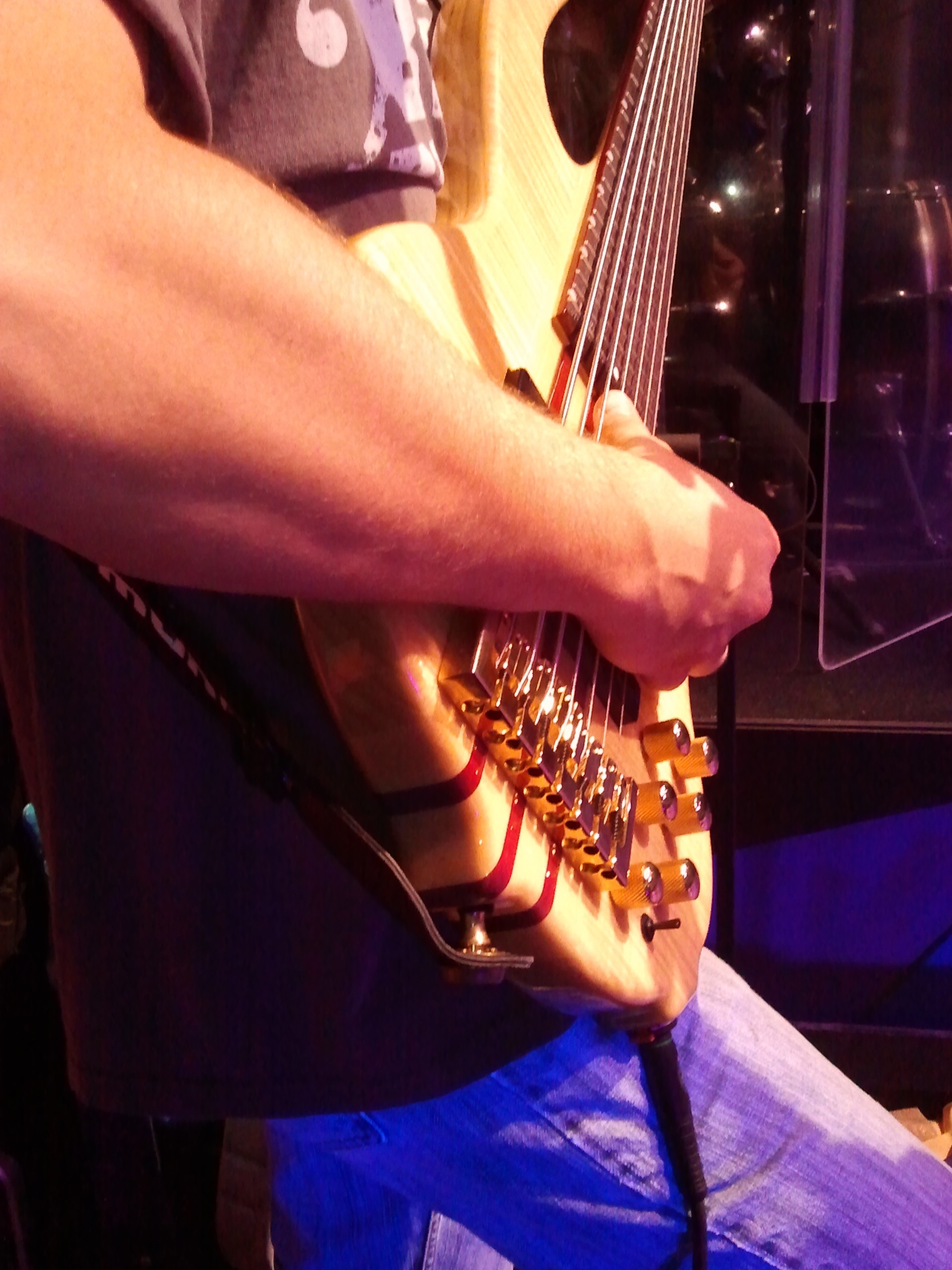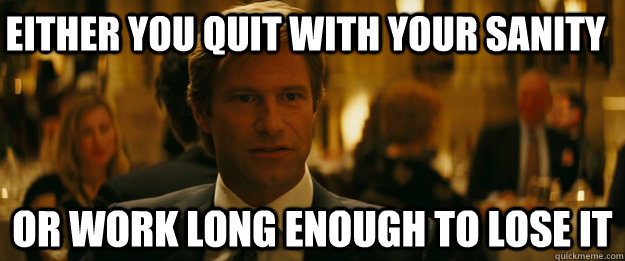Being able to adapt to your surroundings.
It is an essential quality in the survival of the species; it is an essential attribute to the traveling musician. While on tour in Mexico I’ve had to learn several lessons from the road. Some of these lessons deal with my playing, some deal with my personal life, and some deal with the little things like getting from point A to point B without a car. But like with everything in life you learn a little bit each day. And with each bit of information you can build something bigger much like how everything great is built piece by piece.
So this week I’ll talk a little bit about a lesson about playing live, a lesson about living out of a hotel room, and a lesson about staying healthy.
When I got on this tour with Cirque Dreams I wanted to bring a new technique to the show that I’d been working on since getting off the last tour with them. It’s the double-thump technique. That’s when you thump or “slap” the string by striking through the string and letting your thumb rest on the string beneath it then you pull up your thumb and basically pop the string using your thumbnail. You’re basically using your thumb the same way a guitarist uses a pick in what’s called “alternate picking.”
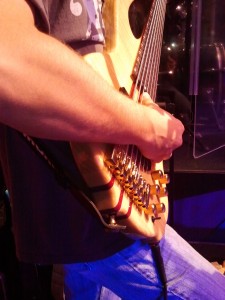 Well, I got pretty good at this technique but one thing that was bothering me was that while I’m doing this my bass guitar rocks back and forth from the motion. This happens because my forearm is anchored on the upper part of the body above the bridge for stability but when I hit through the strings the force of the strike makes the bottom part of the bass roll towards my leg. A lot of this has to deal with the transference of energy from my forearm to my hand, and as each up/down motion completes this transfer goes back and forth.
Well, I got pretty good at this technique but one thing that was bothering me was that while I’m doing this my bass guitar rocks back and forth from the motion. This happens because my forearm is anchored on the upper part of the body above the bridge for stability but when I hit through the strings the force of the strike makes the bottom part of the bass roll towards my leg. A lot of this has to deal with the transference of energy from my forearm to my hand, and as each up/down motion completes this transfer goes back and forth.
To solve this I tried hitting lighter and angling the bass a different way. However, this makes it hard to sing and play as the bass is too close to the mic stand.
I had to come up with a different solution.
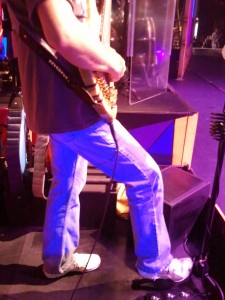 I then came up with using the slight elevation of my boom mic stand as a foot stole. This raises my thigh a bit and prevents the bass from pivoting downwards. This is beneficial in two ways: one it keeps my bass steady as I’m playing in this style; two it helped me develop a better technique in using this double-thump motion so that I didn’t have to use the boom mic stand.
I then came up with using the slight elevation of my boom mic stand as a foot stole. This raises my thigh a bit and prevents the bass from pivoting downwards. This is beneficial in two ways: one it keeps my bass steady as I’m playing in this style; two it helped me develop a better technique in using this double-thump motion so that I didn’t have to use the boom mic stand.
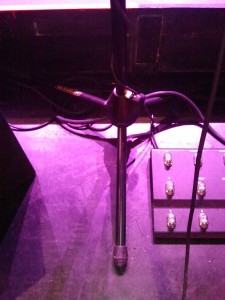 And that’s what practice is all about. As we practice things slowly we train our bodies to operate in a certain way to gain the maximum function. When you practice the double-thump technique slowly you fine tune your arm and hand to move just slightly enough to be able to strike a string in such a way that it can go through to the next string and not simply land and stop on the string without striking through.
And that’s what practice is all about. As we practice things slowly we train our bodies to operate in a certain way to gain the maximum function. When you practice the double-thump technique slowly you fine tune your arm and hand to move just slightly enough to be able to strike a string in such a way that it can go through to the next string and not simply land and stop on the string without striking through.
By using my boom mic stand as a foot rest I was able to play the songs the way I wanted to while fine tuning my attack so that it wouldn’t rock my bass guitar back and forth.
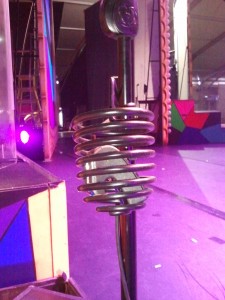 One of the things I use on stage quite a bit is an EBow. A lot of people that use one of these things don’t quite know where to put them when they’re not using them. As a bass player I’m able to hold an EBow in my hand in such a way that allows me to still use my middle and index fingers to play. A guitar player that uses a pick doesn’t have such a luxury. I still have to be able to have access to my EBow from song to song. So I need it close by. I came up with using one of those drink holders that you attach to your mic stand. I simply leave the EBow on for the whole show and pick it up whenever I need it.
One of the things I use on stage quite a bit is an EBow. A lot of people that use one of these things don’t quite know where to put them when they’re not using them. As a bass player I’m able to hold an EBow in my hand in such a way that allows me to still use my middle and index fingers to play. A guitar player that uses a pick doesn’t have such a luxury. I still have to be able to have access to my EBow from song to song. So I need it close by. I came up with using one of those drink holders that you attach to your mic stand. I simply leave the EBow on for the whole show and pick it up whenever I need it.
It’s a handy little solution to the small problem of keeping your EBow readily accessible.
Away from the stage I’ve had to learn what to do to best deal with my laundry situation. Yes, it’s the unglamorous side of touring: laundry day. And I’m lucky that on this tour where all allowed 21 pieces of clothing to be cleaned by the resort for free. But when you’re with the circus you’ll find that most of us are in the gym almost every day. That means we’re all taking multiple showers during the day and use more than one set of clothes.
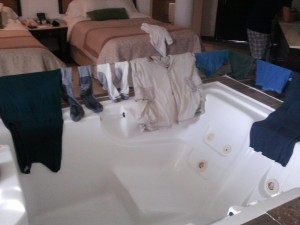 I wasn’t aware that you could wash your clothes in the sink. Look, it’s almost as good as using a washing machine. When you dump your clothes in a washing machine all you’re really doing is dropping them in a big tub of hot water that swishes your clothes back and forth. You can get just as good a wash by doing it by hand.
I wasn’t aware that you could wash your clothes in the sink. Look, it’s almost as good as using a washing machine. When you dump your clothes in a washing machine all you’re really doing is dropping them in a big tub of hot water that swishes your clothes back and forth. You can get just as good a wash by doing it by hand.
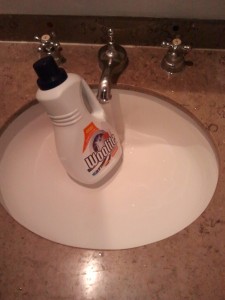 Just fill the sink up with super hot water – hot enough for you to stick your hands in. Then you just pour in a bit of Woolite, put in some socks, let them soak for a few minutes, then rub the socks together to get them all sudsy-like, really rub them together and work in the detergent, then let them soak for a while longer. Then you just drain the water and rinse with cold water. The cold water kills off the suds. After you’ve rinsed the clothes out with cold water you should get the excess water out gently. Any additional moisture can by rung out by putting the clothes in a towel, rolling the towel up, and pressing down on the towel. The point is to not ring out the clothes. This could damage them. Use a towel to get the extra water.
Just fill the sink up with super hot water – hot enough for you to stick your hands in. Then you just pour in a bit of Woolite, put in some socks, let them soak for a few minutes, then rub the socks together to get them all sudsy-like, really rub them together and work in the detergent, then let them soak for a while longer. Then you just drain the water and rinse with cold water. The cold water kills off the suds. After you’ve rinsed the clothes out with cold water you should get the excess water out gently. Any additional moisture can by rung out by putting the clothes in a towel, rolling the towel up, and pressing down on the towel. The point is to not ring out the clothes. This could damage them. Use a towel to get the extra water.
For me, it really cuts the laundry in half. If you’re using a washing machine or a dryer in some hotel the fewer clothes you use means you’ll get a shorter drying time. If you’re at a resort that will do your laundry for free but only restricts you to a limited number of clothing articles then using your sink as a wash basin will help out tremendously as well. When you’re wearing multiple outfits in one day you can benefit from washing a small load of laundry in your sink and letting the clothes dry outside on the balcony or somewhere else in the room.

Now, a couple of days ago I came down with some pretty bad food poisoning. I mean, when all is said and done, pretty much any case of food poisoning is “pretty bad.” I don’t think anyone’s ever had a “cheerful” bout of food poisoning. Listen, having to play two shows a night while trying to hold down food and water is no fun. Food poisoning means you’re dizzy, nauseous, your bones ache, your head hurts, and your stomach is killing you. But the show must go on.
Before I went out on tour I stocked up on some medicine that everyone should have on them for any trip they take.
1) Hydrocortisone cream – for mosquito bites or rashes.
2) Benadryl – for allergies
3) Tylenol PM – sleep aid plus pain relief
4) Cold/Flu medicine
5) Anti-diarrhea medicine
6) Anti-constipation medicine
7) Bribe money
8) Aspirin
9) Band aids
10) Tweezers
11) Brass knuckles
12) Scissors
13) Neosporin
One of the things people say about going to Mexico is “don’t drink the water.” That’s fine and all but what people don’t realize is that it’s kind of hard to avoid the water when that’s what ice is made out of and it’s what’s primarily used to grow fruits and vegetables. The water at the resort is fine since pretty much everything you drink comes from bottled water. The tap water has been filtered at the resort so it’s okay to brush your teeth with it. The real thing to avoid is any fresh fruit from the area.
Food poisoning basically runs its course in about 24 hours. It’s no fun and there’s not a lot you can do for it besides wait it out. Just be mindful of fresh fruit in certain places and eating at buffets that are approaching closing time.
I remember the night I got food poisoning I was at a buffet and some of the food looked like it had been sitting out for a while. Hey, I took a shot and paid for it.
You live and learn, folks. You live and learn.
